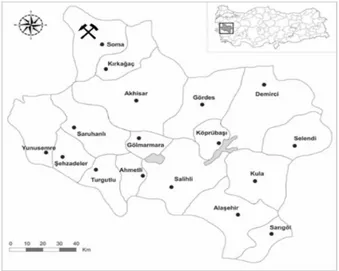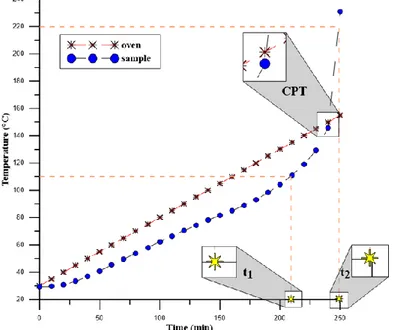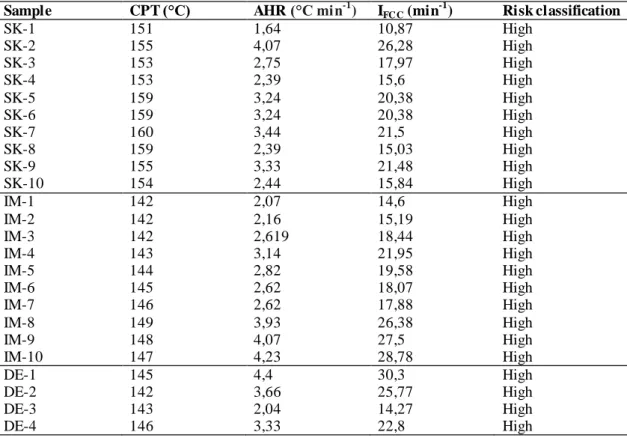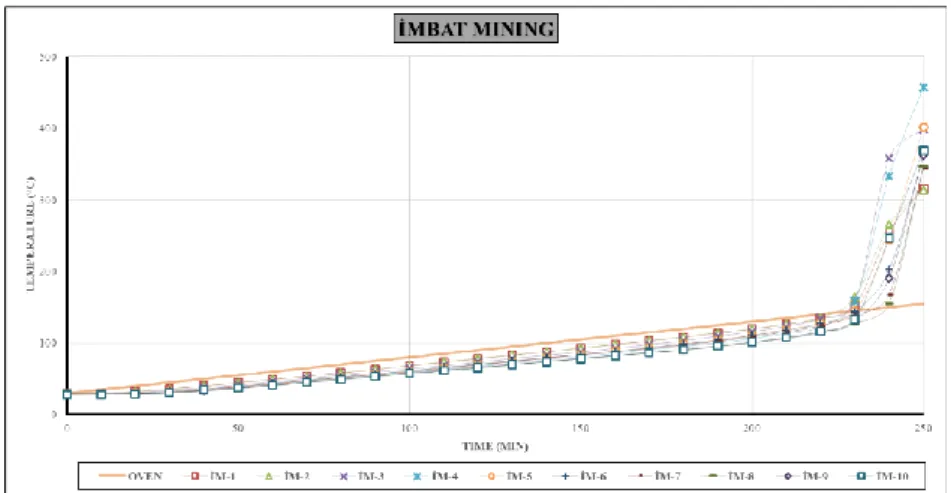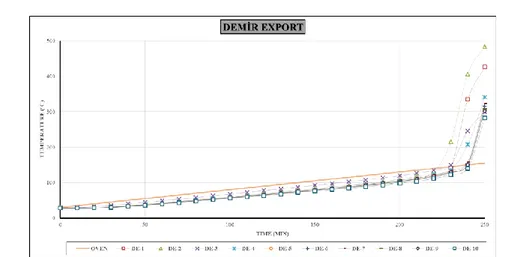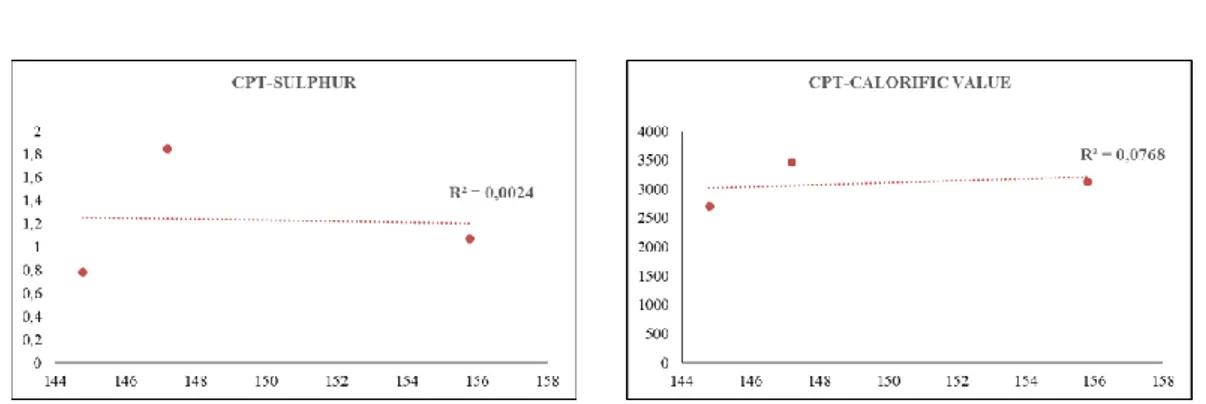RESEARCH ARTICLE
201
INVESTIGATION OF SOMA REGION COALS WITH RESPECT TO SPONTANEOUS COMBUSTION SUSCEPTIBILITY
Hasan Hüseyin ILICA1, Özer ÖREN2, Cem ŞENSÖĞÜT3 1Kütahya Dumlupinar University, Mining Engineering Dept., 43100, Kütahya,
hasanhuseyinilica@outlook.com;
ORCID: 0000-0001-9975-2699
2Kütahya Dumlupinar University, Mining Engineering Dept., 43100, Kütahya,
ozer.oren@dpu.edu.tr; ORCID: 0000-0002-4629-1718
3Kütahya Dumlupinar University, Mining Engineering Dept., 43100, Kütahya,
cem.sensogut@dpu.edu.tr; ORCID: 0000-0001-9192-8813
Recieved Date:08.08.2020 Accepted Date:30.10.2020
ABSTRACT
One of the factors that make coal mining difficult is the spontaneous combustion of coal. Spontaneous combustion including various parameters is not only met in underground mining, but also in surface mining, stockyards and long-distance transport of coal by land and sea. This event, which threatened the occupational safety in mines, has effects of causing loss of lives and defecting human health. In mining enterprises, it causes production losses along with economic losses. It is a serious matter that requires good planning and supervision in order not to cause irreversible damages. Spontaneous combustion of coals develops depending on internal, environmental factors and production methods. In order to eliminate the problems caused by spontaneous combustion, the spontaneous combustion conditions of coals must be determined and classified beforehand. In this study, spontaneous combustion tendencies of Soma Region coals were generally determined with samples taken from Işıklar Colliery, İmbat Mining and Eynez Colliery of Demir Export. Using the crossing point method, a total of 30 experiments were carried out with 10 samples taken from each colliery to find out the risk of spontaneous combustion of the Soma Region coals. Based on the values obtained, it has been determined that the coals of the Soma Region have a "high" tendency to spontaneous combustion. Key words: Coal, Crossing point method, Oxidation, Spontaneous combustion
1. INTRODUCTION
Spontaneous combustion of coals is a natural phenomenon that causes serious losses especially in the mining area and causes environmental pollution as a result of toxic gases released from burning of coal [1]. This problem can be encountered in long-term storage in thermal power stations, including coal stocks, surface mining, underground old production areas, dump sites and even in transport conditions such as long-distance cargo ships or trains [2]. Spontaneous combustion phenomenon has been tried to be enlightened by many researchers and scientists from different disciplines since the 17th century due to the complex structure of coal. Different theories have been developed to explain this phenomenon. Some of these theories; pyrite theory, bacterial theory, phenyl reaction, free radical reaction, hydrogen reaction, activation group reaction and coal - oxygen interaction theory. Among
Ilıca et all., Journal of Scientific Reports-A, Number 45, 201-214, December 2020.
202
these theories, the most accepted approach by researchers is the theory of coal-oxygen interaction [3]. According to this theory, the reactions between coal and oxygen take place in two main stages as "direct combustion" and "chemisorption". In the stage called "direct burning"; oxidation products such as CO, CO2 and H2O are released as a result of the reaction between coal and oxygen [4].
"Chemisorption stage" consists of 4 consecutive sub-stages. These stages can be summarized as follows: 1) physical adsorption of oxygen, increase in temperature; 2) chemical adsorption (above 50°C), production of oxygenetic hydrocarbons or peroxy compounds; 3) decomposition of oxygenetic hydrocarbons when the spontaneous combustion temperature is reached (above 70°C) with simultaneous oxidation of unaltered coal; and 4) the occurrence of the phenomenon called spontaneous combustion when all of the processes in the first three substances cause temperatures higher than 150°C, typically defined as the ignition threshold [5]. Figure 1 shows the general reaction steps in coal oxidation [6].
Figure 1. Reaction steps taking place in coal oxidation.
Many factors can affect the spontaneous combustion of coals. In the literature, these factors are divided into two as internal and external factors. While internal factors are mostly related to the physical properties of coal or rocks with organic content; External factors concern the geological characteristics of the coal seam and the site where the seam is located and the framework of the production method applied during mining. The parameters effective in spontaneous combustion are shown in detail in Table 1 [7]. In general, since low-rank coals contain more reactive moisture, oxygen and volatile matter, they are more prone to spontaneous combustion than high-rank coals [8]. Different opinions are put forward on the effects of moisture content in coal on oxidation and spontaneous combustion.
Table 1. Parameters effective in spontaneous combustion of coal.
Internal (endogenous) factors External (exogenous) factors
Coal features Geological features Atmospheric conditions Factors related to mining
Carbonization degree Petrographic structure Moisture content Mineral matter content Particle size Pyrite content Physical features Bacteria Seam thickness Seam slope Collapse feature Tectonic faults Depth Geothermic gradian Temperature Moisture Oxygen concentration Production method Advance rate Pillar conditions Roof conditions Main gate conditions Air leakage Coal losses Mined out areas Filling conditions Ventilation pressure Air moisture
Ilıca et all., Journal of Scientific Reports-A, Number 45, 201-214, December 2020.
203
It was found by the researchers that there is a critical humidity range value for the value at which coal's oxygen consumption is maximum; it has been stated that oxygen consumption rates decrease for coals below or above this humidity range [9]. Considering coal oxidation and the spontaneous combustion process is an event that occurs on the surface and pores of the coal. In the researches to date; it has been stated that the surface area increases as a result of the decrease in the particle size o f the coal and it has the role of increasing spontaneous combustion since it allows the formation of additional surfaces that will come into contact with oxygen [10]. It is possible to say that high mineral substance content will reduce the spontaneous combustion of coal, since the increase of mineral substance in coal will decrease the amount of carbon in its structure. Apart from that, in the past studies, the oxidation accelerator of lime, soda and iron compounds in the coal structure ; it is stated that minerals such as aluminum and silica have an effect that slows down the process in concern [11]. Especially in the literature, it has been stated that this ratio should be above 2% for pyrite to play an effective role in spontaneous combustion [12]. Contrary to this view, there are also studies suggesting that pyrite does not mean anything on its own and requires a certain amount of moisture to function as a catalyst in oxidation, and that pyrite alone does not contribute to oxidation in tests on dry sample s [13]. The effects of coal petrography on spontaneous combustion are also among the topics that attract the attention of researchers in the literature. It is generally accepted that coals with high reactivity macerals such as liptinite and vitrinite are prone to spontaneous combustion [14]. Apart from internal factors, other factors that are effective in spontaneous combustion are external factors. External factors such as seam thickness and depth, ventilation and production method and advance rate stand out among external factors when evaluated in terms of the effect level. As the thickness of the coal seam increases, the thermal conductivity of the coal decreases and the heat accumulation in the coal may increase. In the block caving methods, which are frequently used in the excavation of thick coal seams, coal pieces with a fractured structure that have been abandoned without being produced in the goaf prepare the ground for spontaneous combustion [15]. It is stated in the literature that coal deposits with a thickness of more than 5 m are more prone to spontaneous combustion [16]. With the increasing depth, the risk of spontaneous combustion of coal increases in parallel. Rock pressure on coal in deep coal mines leads to breaking and cracking of the pillars left and especially the coal pieces at the coal face. These fractures and cracks form free surfaces for the coal to contact with oxygen [17]. Apart from this, it is stated in the literature that the geothermal gradient will increase as a result of the increase in the depth, the temperature of the coal and the surrounding rocks will increase as a result of this increase, and this will prepare a suitable environment for spontaneous combustion [11]. In general, as a result of the temperature increase of every 10°C at temperatures between 30-100°C, the oxidation rate of coal increases on average 2.2 times [18]. When examined in terms of atmospheric conditions in the mine, the effect of the amount of moisture in the air on spontaneous combustion is also shown among the parameters affecting spontaneous combustion. It is stated that humid air acting on the coal surface produces 2.5 times more heat than dry air [19]. If the partial pressure of the humidity in the air is high, moisture exchange between coal and atmospheric air, and the heat released during condensation may cause the temperature of the coal to increase and the risk of spontaneous combustion to increase [20]. The advanced longwall method is a more dangerous method for spontaneous combustion compared to the retreating longwall method due to the continuous air flow of the coals behind the goaf. In retreating longwall method, since the main gate roads are in the coal, air cannot find any way to escape and thus air leaks can be reduced to a minimum. In addition, different chemicals called inhibitors can be used to prevent the spontaneous combustion of coals and basically limit the contact of oxygen with coal. The inhibitors in wide range from inorganic salts such as NaCl, MgCl2, CaCl2 to antioxidants that can also be used in food products [21, 22].
Ilıca et all., Journal of Scientific Reports-A, Number 45, 201-214, December 2020.
204
Mine fires caused by spontaneous combustion events in our country have caused a great loss of life and property in important enterprises such as the Turkish Hard Coal Enterprises and the Western Lignite Corporation [23, 24]. Studies of the determining to spontaneous combustion liability carried out by many researchers on various coals in our country have gained momentum after these events. Spontaneous combustion studies carried out by different researchers in different institutions, especially in the Zonguldak region, have given important ideas in terms of the oxidation characteristics of coal in the region [25-29]. In addition, in studies conducted at the Western Lignite Corporation, the ignition temperature of coals was determined as 138 -146ºC and they were included in the high-risk coal [30]. Kadıoğlu ve Varamaz [31] examined the effects of moisture and dried air on the ignition temperatures of Aşkale and Balkaya lignites, found that the moisture content increased the ignition temperature values, while the ignition temperatures of coals passed through dry air decreased. Şensöğüt ve Çınar [32] determined the ignition temperatures of coals of Konya – Ermenek region as 151–160ºC and the liability index values as 4,4–7,3.
The center of the studies from the past to the present is the determination of the factors affecting the spontaneous combustion process, their prevention at the beginning of the combustion process or their disposal afterwards, and the determination of the spontaneous combustion tendency of the coal or organic rocks. Considering that spontaneous combustion is an actual process and the seam depth and coal structure may change with the production processes, it is important to carry out susceptibility measurements and risk assessments periodically. With this study, spontaneous combustion risks of coal samples taken from underground production faces of three separate private enterprises that continue their activities in the Soma region were determined.
2.MATERIAL AND METHOD
2.1. Preparation of Samples
Examples of lignite used in the study have been obtained from the production panels of three different private enterprises operating in the field of underground mining in Soma district of Manisa province (Demir Export / M2 panel, İmbat Mining / D11 panel and Soma Coal Enterprises / panel 8) (Figure 2).
Ilıca et all., Journal of Scientific Reports-A, Number 45, 201-214, December 2020.
205
The samples obtained from the underground coal mines were covered with aluminum foil and stretch film in order to avoid oxidation and were quickly brought to the Mining Engineering Laboratories of Kütahya Dumlupinar University in closed containers. Subsequently, all samples were reduced to -75 µm in size and placed in airtight bags of approximately 200 g and preserved in the deep freezer until the test processes. The chemical analysis results of the samples have been obtained from the enterprises and are given in Table 2.
Table 2. Chemical analysis results of coal samples.
Analysis Soma Coal Enterprises İmbat Mining Demir
Export
Original total moisture (%) 10,0 11,7 10,6
Dried ash (%) 40,07 46,21 44,52
Dried volatile matter (%) 39,60 37,49 38,54
Dried fixed carbon (%) 19,43 18,89 17,81
Dried total sulphur (%) 1,07 0,78 1,85
Dried upper cal. val. (cal/g) 3127 2698 3461
Dried lower cal. val. (cal/g) 2959 2544 3281
2.2. Experimental Studies
Many methods and experimental devices have been developed in different countries of the world in determining the spontaneous combustion behavior of coals. Among the most commonly used of these experimental systems are isothermal and adiabatic calorimeter method [33, 34], dinamic oxidation method [26], basket heating method [35], Olpinski’s method [36], TGA/DTA (thermogravimetric analysis/differential thermogravimetric analysis) [37, 38] ve crossing point temperature method [39]. The crossing point temperature method has advantages over other methods due to reasons such as ease of installation of the experimental set, low cost and widespread use in major coal producing countries such as China, India. In determining the spontaneous combustion tendency of the coals that are the subject of the present study, the set up that is currently operating in Kütahya Dumlupinar University, Mining Engineering Department, Spontaneous Combustion Test Laboratory was used (Figure 3). The set up in concern consists of an oven (Carbolite PF120, England) allowing to program and ramp at different temperature and time intervals, a chromium-nickel alloy reactor in which the coal sample is placed and the combustion takes place, thermocouple and data recorder (Testo 175-T3, Germany) for measuring the temperature of the coal in the reactor and flow meter (Cole Parmer, Dual -Float SN-32466-04, USA) that provides air to the coal at desired flow rates and oxygen and nitroge n cylinders.
Ilıca et all., Journal of Scientific Reports-A, Number 45, 201-214, December 2020.
206
Figure 3. Spontaneous combustion test set up.
The crossing point method, which is widely used in the literature, was used to determine the spontaneous combustion susceptibility of the coals. In the experiments, 100 g coal samples reduced to -75 µm size were used.
Figure 4. A typical spontaneous combustion curve.
At the beginning of the experiment, the coal sample was put into the reactor and the gas inlet and outlet connections of the reactor were made, and oxygen was not given into the reactor until the temperatures of the oven and coal sample equaled to 30°C during the equilibrium time period. Nitrogen gas was introduced into the reactor during the equilibrium time to prevent the coal from oxidizing. At the point where the process was completed and the temperatures of the coal and oven
Ilıca et all., Journal of Scientific Reports-A, Number 45, 201-214, December 2020.
207
were equalized, oxygen was introduced to the reactor at a flow of 200 cc/min with 99.6% purity, and after this stage, the temperature values of the coal and oven were recorded every 10 minutes. In the experimental process, the temperature increase of the oven was set as 0.5°C/min and the temperature changes in the coal and oven were observed until the end of the experiment. The temperature of the coal sample oxidized over time reaches the temperature of the oven, which increases linearly, and the temperature of the oven and coal intersect at one point. While this point is called the "crossing point" in the literature, the temperature at that point is expressed as the "ignition temperature" (Figure 4). 2.3. Determination of Spontaneous Combustion Liabilities of Coals.
Spontaneous combustion tendencies of coals were determined by using the data obtained during the experiment. Empirical equation developed by Feng, Chakravorty and Cochrane [40] was used when making susceptibility classification (Equation 1 & 2). The formulation of the mentioned index and the explanations of the variables used in the formulation are given below.
IFCC= Average Heating Rate (AHR)
Crossing Point Temperature (CPT) × 1000 (1)
Here;
IFCC : Feng, Chakravarty, Cochrane index, min-1.
AHR : Average Heating Rate between 110 - 220°C, °C min-1
Average heating rate (AHR) is calculated by the formula given below; AHR =t110
2−t1 (2) Where;
t2: time when the coal sample reaches a temperature of 220°C, min
t1: Time when the coal sample reaches a temperature of 110°C, min
By using the index (IFCC), the spontaneous combustion tendencies of coals are classified as shown in Table 3.
Table 3. Liability classification of coals according to IFCC index. Susceptibility index Risk category
0-5 low
5-10 medium
>10 high
3. CONCLUSION
In this study, spontaneous combustion characteristics of the coals procured from Soma Coal Enterprises (SK), Imbat Mining (IM) and Demir Export (DE) which continue their coal production activities in the Soma region were determined using the crossing point method. For each coal sample belonging to each enterprise, 10 crossing point tests were conducted and the results were examined.
Ilıca et all., Journal of Scientific Reports-A, Number 45, 201-214, December 2020.
208
The test results and intersection graphs of all coals are given in detail in Table 4 and Figure 5 -7, respectively.
When the experimental results are examined, the ignition temperatures of the samples taken from Panel 8, Soma Coal Enterprises are between 151 - 160°C; average heating rates ranged from 1.64 - 4.07°C min-1 and susceptibility indices ranged from 10.87 - 26.28 min-1.
Ignition temperatures of samples taken from D11 panel, Imbat Mining are 142 - 149°C; While average heating rates were determined between 2.07 - 4.23°C min-1, the susceptibility index values were determined between 14.6 - 28.78 min-1.
Ignition temperatures of the sample taken from M2, Demir Export panel are 142 - 151°C; average heating rates were found between 2.04 - 4.4°C min-1, whereas susceptibility indices were determined as 14.27 - 30.3 min-1.
In the light of the data obtained, Soma Basin lignite coals were identified as “high risk” in terms of spontaneous combustion. Although these results support the studies carried out in previous years; considering the parameters on spontaneous combustion and changes in production processes, it is vital to repeat spontaneous combustion susceptibility measurements and to evaluate production plans according to the risk scale in question.
Table 4. Spontaneous combustion results for all coal samples. Sample CPT (°C) AHR (°C min-1) IFC C (min
-1 ) Risk classification SK-1 151 1,64 10,87 High SK-2 155 4,07 26,28 High SK-3 153 2,75 17,97 High SK-4 153 2,39 15,6 High SK-5 159 3,24 20,38 High SK-6 159 3,24 20,38 High SK-7 160 3,44 21,5 High SK-8 159 2,39 15,03 High SK-9 155 3,33 21,48 High SK-10 154 2,44 15,84 High IM-1 142 2,07 14,6 High IM-2 142 2,16 15,19 High IM-3 142 2,619 18,44 High IM-4 143 3,14 21,95 High IM-5 144 2,82 19,58 High IM-6 145 2,62 18,07 High IM-7 146 2,62 17,88 High IM-8 149 3,93 26,38 High IM-9 148 4,07 27,5 High IM-10 147 4,23 28,78 High DE-1 145 4,4 30,3 High DE-2 142 3,66 25,77 High DE-3 143 2,04 14,27 High DE-4 146 3,33 22,8 High
Ilıca et all., Journal of Scientific Reports-A, Number 45, 201-214, December 2020. 209 DE-5 150 3,33 22,2 High DE-6 149 3,7 24,83 High DE-7 148 2,82 19,05 High DE-8 149 3,06 20,54 High DE-9 149 3,24 21,74 High DE-10 151 3,93 26,03 High
Figure 5. Time-temperature curves of experiments belonging to Soma Coal Enterprises (SK).
Ilıca et all., Journal of Scientific Reports-A, Number 45, 201-214, December 2020.
210
Figure 7. Time-temperature curves of experiments belonging to Demir Export (DE).
In addition, the relations between the proximate analysis values of coals and the ignition temperatures are given in Figure 8. During the investigation of this relationship, the average ignition temperatures obtained in 10 experiments for each coal sample were taken and the correlation between them was investigated. According to the results obtained, it is possible to say that the most significant relationship with the ignition temperatures of coals is with the ash content in coal. In general, as the amount of ash in coal increases, the ignition temperature values decrease. It is believed that this condition is caused by the content of mineral substances that accelerate oxidation found in the ash of coal, as revealed in some studies conducted in the past [41].
Ilıca et all., Journal of Scientific Reports-A, Number 45, 201-214, December 2020.
211
Figure 8. Relationship between proximate analysis values of coals and ignition temperatures.
ACKNOWLEDGEMENT
The authors give endless thanks to the authorities of Soma Coal Enterprises, Imbat Mining and Demir Export due to the help and conveniences they showed during the sample procurement stage.
REFERENCES
[1] Carras, J. N., Day, S. J., Saghafi, A. and Williams, D. J. (2009). Greenhouse gas emissions from low-temperature oxidation and spontaneous combustion at open-cut coal mines in Australia. Int. J. of Coal Geology, 78(2), 161–168.
[2] Fierro, V., Miranda, J. L., Romero, C., Andrés, J. M., Arriaga, a., Schmal, D. and Visser, G. H. (1999). Prevention of spontaneous combustion in coal stockpiles: Experimental results in coal storage yard. Fuel Processing Technology, 59(1), 23–24.
[3] Qi, X., Wang, D., Zhong, X., Gu, J. and Xu, T. (2010). Characteristics of oxygen consumption of coal at programmed temperatures. Mining Science and Technology (China), 20(3), 372 –377. [4] Carras, J. N., Young, B. C. (1994). Self-heating of coal and related materials: Models,
application and test methods. Progress in Energy and Combustion Science, 20(1), 1 –15. [5] Gürdal, G., Hoşgörmez, H., Özcan, D., Li, X., Liu, H. and Song, W. (2015). The properties of
Çan Basin coals (Çanakkale—Turkey): Spontaneous combustion and combustion by-products. Int. J. of Coal Geology, 138, 1–15.
[6] Wang, H., Dlugogorski, B. Z. and Kennedy, E. M. (2003). Coal oxidation at low temperatures: oxygen consumption, oxidation products, reaction mechanism and kinetic modelling. Progress in Energy and Combustion Science, 29(6), 487–513.
[7] Güney, M., (1968). Certain factors affecting the oxidation and spontaneous combustion of coal. University of Nottingham, Mining Dept. Magazine, 20, 71 – 80.
Ilıca et all., Journal of Scientific Reports-A, Number 45, 201-214, December 2020.
212
[9] Wang, H., Dlugogorski, B. Z. and Kennedy, E. M. (2003). Analysis of the mechanism of the low-temperature oxidation of coal. Combustion and Flame, 134(1–2), 107–117.
[10] Akgün, F., Arisoy, A. (1994). Effect of particle size on the spontaneous heating of a coal stockpile. Combustion and Flame, 99(1), 137–146.
[11] Didari, V. (1986). Yeraltı ocaklarında kömürün kendiliğinden yanması ve risk indeksleri. Madencilik Dergisi, 25(4), 29-34.
[12] Arisoy, A., Beamish, B. (2015). Mutual effects of pyrite and moisture on coal se lf-heating rates and reaction rate data for pyrite oxidation. Fuel, 139, 107-114.
[13] Beamish, B., Lin, Z. and Beamish, R. (2012). Investigating the influence of reactive pyrite o n coal self-heating. Proc. of the Twelfth Coal Operators Conference (pp.294-299), Wollongong, Australia.
[14] Stracher, G.B.,Prakash, A. and Ellina, V.S. (2010). Coal and peat fires – A global perspective. vol.I: coal, geology and combustion, p.343
[15] Gill, F., Browning, E. (1971). Spontaneous combustion in coal mines. Colliery Guardian, 219, 79-85.
[16] Banerjee, S.C. (1985). Spontaneous combustion of coal and mine fires. A.A. Balkema / Rotterdam, 167 s.
[17] Kural, O. (1988). Kömür kimyası ve teknolojisi.
[18] Erkan, H. (1964). Kömürün depolanması. Madencilik, 3, 12-13.
[19] Karpuz, C., Güyagüler, T., Bağcı, S., Bozdağ, T., Başarır, H. ve Keskin, S. (2000). Linyitlerin kendiliğinden yanmaya yatkınlık derecelerinin tespiti: Bölüm I – Risk sınıflaması derlemesi. Madencilik Dergisi, 3-13.
[20] Kural, O. (1998).Kömür özellikleri, teknolojisi ve çevre ilişkileri. Özgün Ofset Matbaacılık A.Ş. [21] Wang, D.; Dou, G.; Zhong, X.; Xin, H.; Qin, B. (2014). An experimental approach to selecting
chemical inhibitors to retard the spontaneous combustion of coal. Fuel, 117, 218-223.
[22] Li, J., Li, Z., Yang, Y., Zhang, X., Yan, D. and Liu, L. (2017). Inhibitive Effects of Antioxidants on Coal Spontaneous Combustion. Energy Fuels, 31(12), 14180-14190.
[23] Saraç, S. (1992). Yeraltı Kömür Ocaklarında Kendiliğinden Yanma. Anadolu Üniversitesi Mühendislik – Mimarlık Fakültesi Yayınları, 106-118.
[24] Soytürk, T. (1992). Tunçbilek Kömürlerinin Kendiliğinden Yanmaya Yatkınlıklarının Araştırılması. Yüksek Lisans tezi Anadolu Üniversitesi Fen Bilimleri Enstitüsü, 77.
Ilıca et all., Journal of Scientific Reports-A, Number 45, 201-214, December 2020.
213
[25] Şahin, N., Didari, V. (2002). Zonguldak Kömürlerinde Kendiliğinden Yanmanın Erken Saptanması Amacıyla Yanma Ürünü Gazların İncelenmesi. Madencilik, 41, (4) 37– 51.
[26] Ayvazoğlu, E., 1978; EKİ Kozlu bölgesi Çay ve Acılık Kömürlerinin Oksidasyonunun Erken Tespiti Yönünden İncelenmesi. Türkiye 1. Kömür Kongresi, 539 – 563.
[27] Karaçam, E., Didari, V., Atalay, T. (1988). Zonguldak Kömürlerinin Kendiliğinden Yanmaya Yatkınlıklarının Araştırılması. Türkiye 6. Kömür Kongresi, 91 – 100.
[28] Yılmaz, A.O., Atalay, T. (1990). TTK Armutçuk Müessesesinde Kendiliğinden Yanma Olayının Araştırılması. Türkiye 7. Kömür Kongresi, 399–410.
[29] Kaymakçı, E. (1998). Zonguldak Havzası Kömür Damarlarına Uygulanabilecek bir Kendiliğinden Yanmaya Doğal Yatkınlığı Değerlendirme Tekniğinin Geliştirilmesi. Doktora tezi Zonguldak Karaelmas Üniversitesi Fen Bilimleri Enstitüsü.
[30] Saraç, S., Soytürk, T. (1992). Tunçbilek Kömürlerinin Kendiliğinden Yanmaya Yatkınlıklarının araştırılması. Türkiye 8. Kömür Kongresi, 141–152.
[31] Kadioglu, Y., Varamaz, M. (2003). The Effect of Moisture Content and Air – Drying on Spontaneous Combustion Characteristics of Two Turkish Lignites. Fuel, (82) 1685-1693. [32] Sensogut, C., Cinar, I. (2000). A Research on the Tendency of Ermenek District Coals to
Spontaneous Combustion. Mineral Resources Engineering, 9(4), 421– 427.
[33] Beamish, B.B., Barakat, M.A., St.George, J.D. (2000. Adiabatic testing procedures for determining self-heating propensity of coal and sample ageing effects. Thermochimica Acta, 362, 79-87.
[34] Zubíček, V., Adamus, A. (2013). Susceptibility of coal to spontaneous combustion verified by modified adiabatic method under conditions of Ostrava-Karvina coalfield, Czech Republic. Fuel Processing Technology, 113, 63-66.
[35] Chen, X.D. (1999). On basket heating methods for obtaining exothermic reactivity of solid materials: The extent and impact of the departure of the crossing-point temperature from the oven temperature. Process Safety and Environmental Protection, 77(4), 187-192.
[36] Zubíček, V. (2008). Assessment of susceptibility of coal to spontaneous combustion in OKR. Geoscience Engineering, 4, 1-9.
[37] Avila, C., Wu, T., Lester, E. (2014). Estimating the spontaneous combustion potential of coals using thermogravimetric analysis. Energy&Fuels, 28, 1765-1773.
[38] Pis, J.J., de la Puente, G., Fuente, E., Moran, A., Rubiera, F. (1996). A study of the self-heating of fresh and oxidized coals by differantial thermal analysis. Thermochimica Acta, 279, 93-101. [39] Oren, O., Sensogut, C. (2010). Spontaneous combustion liability of Kutahya (Turkey) region
Ilıca et all., Journal of Scientific Reports-A, Number 45, 201-214, December 2020.
214
lignites. Energy Sources, Part A: Recovery, Utilization and Environmental Effects, 32, 877 -885. [40] Feng, K.K., Chakravorty, R.N. and Cochrane, T.S. (1973). Spontaneous combustion – a coal
mining hazard. The Canadian Mining and Metall. Journal, 66(738), 75–84.
[41] Beamish, B. B., Blazak, D.G. (2005). Relationship Between Ash Content and R70 Self-heating Rate of Callide Coal. International Journal of Coal Geology, 64, 126-132.

